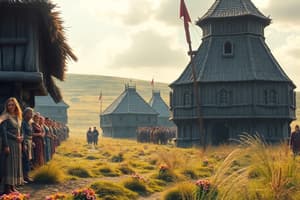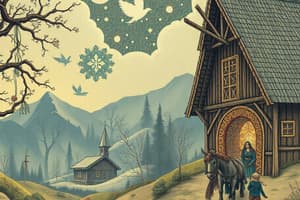Podcast
Questions and Answers
How did the Vikings' geographical location most significantly influence their diet?
How did the Vikings' geographical location most significantly influence their diet?
- It encouraged a diet primarily based on livestock due to extensive pasturelands.
- It restricted their diet to only locally available resources, limiting variety.
- It led to a primary reliance on grains and cultivated vegetables due to fertile lands.
- It fostered a diet heavily reliant on seafood due to their proximity to the sea. (correct)
What role did trade networks play in shaping Viking culinary practices?
What role did trade networks play in shaping Viking culinary practices?
- Trade facilitated the exchange of culinary ideas but rarely led to the import of actual food items.
- Trade allowed access to non-local food items, enriching their culinary options. (correct)
- Trade primarily influenced the types of cooking tools Vikings used, not the ingredients themselves.
- Trade had minimal impact as Vikings preferred to rely solely on locally sourced foods.
How did seasonal changes primarily influence the food habits of the Vikings?
How did seasonal changes primarily influence the food habits of the Vikings?
- Seasonal changes mainly affected the types of pottery used for cooking different foods.
- Seasonal changes only affected the timing of feasts and celebrations, not daily diet.
- Seasonal changes dictated dietary patterns based on food availability. (correct)
- Seasonal changes had little impact because Vikings primarily relied on trade for consistent food supply.
What does the communal eating style of the Vikings suggest about their social values?
What does the communal eating style of the Vikings suggest about their social values?
Why was the preservation of food particularly crucial for Vikings?
Why was the preservation of food particularly crucial for Vikings?
How did social hierarchy affect food consumption among the Vikings?
How did social hierarchy affect food consumption among the Vikings?
What can archaeological food remains primarily reveal about Viking food culture?
What can archaeological food remains primarily reveal about Viking food culture?
What was the significance of ale and mead in Viking culture?
What was the significance of ale and mead in Viking culture?
How did Viking longships primarily influence Viking society and its interactions with other cultures?
How did Viking longships primarily influence Viking society and its interactions with other cultures?
How did the integration of Vikings into European societies impact their dietary habits?
How did the integration of Vikings into European societies impact their dietary habits?
What role did Norse mythology play in the dietary practices of Vikings?
What role did Norse mythology play in the dietary practices of Vikings?
How did regional differences in Scandinavia affect Viking food availability and diet?
How did regional differences in Scandinavia affect Viking food availability and diet?
What preservation techniques did Vikings use, and why were these methods important for their survival?
What preservation techniques did Vikings use, and why were these methods important for their survival?
How does archaeological evidence contribute to our understanding of Viking diets?
How does archaeological evidence contribute to our understanding of Viking diets?
How did trade influence Viking cuisine and dietary habits?
How did trade influence Viking cuisine and dietary habits?
What role did cereal grains play in the Viking diet, and how were they typically prepared?
What role did cereal grains play in the Viking diet, and how were they typically prepared?
Flashcards
Viking Livestock
Viking Livestock
Animals like cattle, sheep, goats, and pigs raised for meat and dairy.
Hunting and Fishing
Hunting and Fishing
Adding to their diet through hunting animals and catching fish.
Viking Age time span?
Viking Age time span?
Roughly from the late 8th to the mid-11th century.
Viking origin?
Viking origin?
Norway, Sweden, and Denmark.
Signup and view all the flashcards
Communal Meals
Communal Meals
Simple meals eaten together from shared bowls.
Signup and view all the flashcards
Viking Brews
Viking Brews
Different kinds of ale and mead.
Signup and view all the flashcards
Viking social classes?
Viking social classes?
Jarls (nobles), karls (free people), and thralls (slaves).
Signup and view all the flashcards
Viking longships?
Viking longships?
Advanced ships used for raiding and navigation.
Signup and view all the flashcards
Preserved Foods
Preserved Foods
Voyages required food that could last a long time.
Signup and view all the flashcards
Viking Hospitality
Viking Hospitality
Kindness in sharing food with visitors.
Signup and view all the flashcards
Viking activities?
Viking activities?
Trade, raids, and exploration across Europe.
Signup and view all the flashcards
Religious Foods
Religious Foods
Food linked to beliefs, offered to the gods.
Signup and view all the flashcards
Main Norse Gods?
Main Norse Gods?
Odin, Thor and Freyja.
Signup and view all the flashcards
What are sagas?
What are sagas?
Insights into Viking history and culture.
Signup and view all the flashcards
Environmental Diet
Environmental Diet
Adapting food choices to what was available.
Signup and view all the flashcards
Viking integration?
Viking integration?
Conversion to Christianity and blending with European culture.
Signup and view all the flashcardsStudy Notes
- The Viking Age generally spans from the late 8th to the mid-11th century.
- Vikings originated from Scandinavia, which includes modern-day Norway, Sweden, and Denmark.
- Viking society was structured with a hierarchy of jarls (nobles), karls (free people), and thralls (slaves).
- Viking longships were advanced for their time, enabling both coastal raiding and river navigation.
- Vikings engaged in extensive trade, raiding, and exploration throughout Europe and beyond.
- Norse mythology was a significant part of Viking culture, with gods like Odin, Thor, and Freyja.
- The sagas are primary literary sources providing insights into Viking history and culture.
- The Vikings eventually integrated into European societies through conversion to Christianity and assimilation.
- Viking diets varied based on location, social status, and season.
- Cereal grains like barley, oats, and rye were staples in the Viking diet
- Bread, porridge, and ale were commonly made from these grains.
- Meat, including beef, pork, mutton, and game, was an important part of the Viking diet
- Fish, both freshwater and saltwater, was crucial, especially in coastal areas.
- Dairy products such as milk, cheese, skyr (yogurt), and butter were common.
- Vegetables like beans, peas, cabbage, onions, and herbs were cultivated or gathered.
- Fruits, including apples, berries, and wild fruits, were consumed seasonally.
- Nuts and seeds were part of the Viking diet, providing fats and nutrients.
- Viking food preparation included methods such as boiling, roasting, smoking, and fermenting.
- Spices and flavorings included herbs, honey, and imported spices when available.
- Ale and mead were popular alcoholic beverages, while water and milk were common non-alcoholic drinks.
- Archaeological evidence, including kitchen middens and grave finds, provides information about Viking diets.
- Isotope analysis of bones reveals details about the dietary habits and origins of Viking populations.
- Trade brought new foods and ingredients into the Viking world, influencing their cuisine.
- Regional differences in food availability and agricultural practices shaped local Viking diets.
- Food played a role in Viking rituals and feasts, with specific dishes served on holidays and at celebrations.
- Food preservation techniques such as drying, smoking, and salting were essential for storing food during winter.
- The Vikings had knowledge of herbal remedies and used plants for medicinal purposes.
- Viking farming was often challenging due to the harsh climate and terrain.
- Livestock, including cattle, sheep, goats, and pigs, were essential for meat and dairy production.
- Hunting and fishing supplemented the Viking diet, providing valuable sources of protein.
- Viking meals were often simple and communal, eaten from shared bowls or trenchers.
- Social status influenced the quality and quantity of food available to individuals.
- Some Vikings were skilled brewers, developing various types of ale and mead.
- The Vikings used a variety of tools and implements for cooking and food preparation.
- Viking long voyages required preserved foods that could last for extended periods.
- Norse sagas and poems provide glimpses into Viking food culture and dining customs.
- The Vikings valued hospitality and generosity, often sharing food with guests and travelers.
- Certain foods were associated with religious beliefs and were offered to the gods.
- Viking trade networks facilitated the exchange of food and culinary ideas across regions.
- Viking settlements in different areas show variations in dietary habits and agricultural practices.
- Viking food culture gradually changed over time as they adopted new customs and ingredients.
- Environmental conditions greatly impacted Viking agriculture and food production.
- Understanding Viking food habits provides insights into their daily lives and cultural values.
- The Vikings adapted their diets to the resources available in their environment.
- Seafood was a significant component of the Viking diet due to their proximity to the sea.
- Trade allowed access to food items not locally available, enriching their culinary options.
- Viking communities relied on collaborative efforts in farming, fishing, and food preservation.
- Food remains found at archaeological sites help reconstruct Viking culinary practices.
- Viking feasts were important social events where food and drink played a central role.
- Norse mythology includes stories about gods feasting and consuming special foods.
- The Vikings had a practical approach to food, utilizing all parts of plants and animals.
- Seasonal changes influenced the availability of food and dictated dietary patterns.
- The Vikings developed techniques for preserving and storing food to survive long winters.
- Social hierarchy affected the types and quantities of food consumed by different groups.
- Ale and mead were culturally significant beverages often used in rituals and celebrations.
- Archaeological findings continue to expand our knowledge of Viking food habits.
- The study of Viking food culture provides a deeper understanding of their way of life.
Studying That Suits You
Use AI to generate personalized quizzes and flashcards to suit your learning preferences.




